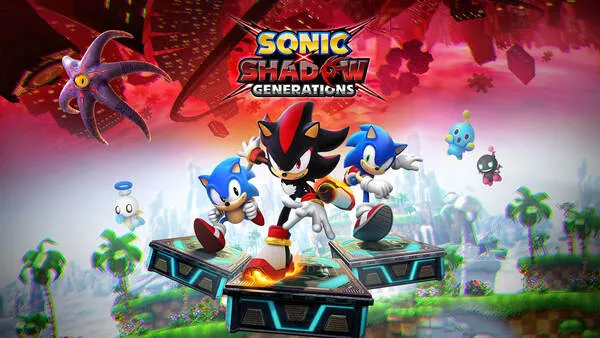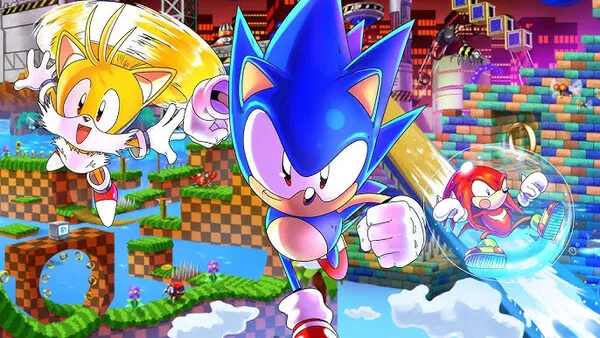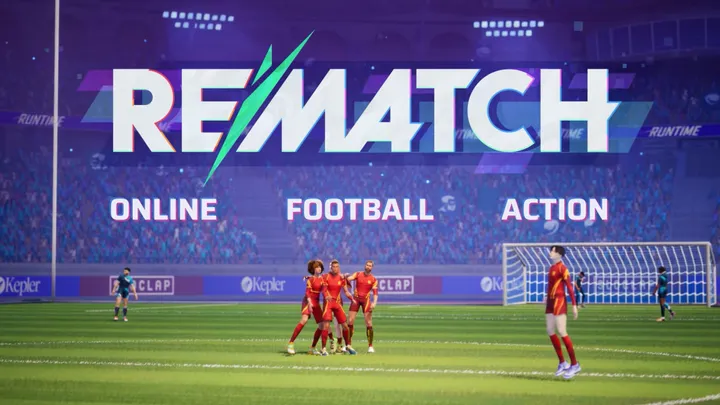Introduction
Sonic the Hedgehog™ Classic, released in 1991 by SEGA, is a cornerstone of video game history. As one of the original platformers to bring high-speed action to the forefront, it changed the way players interacted with their environment. While the game may seem simple on the surface—a blue hedgehog running through colorful environments to defeat a villain—its success lies in its innovative level design, integration of speed mechanics, and challenge to players. However, there is one aspect that stands out in Sonic’s classic formula, and it’s the game’s balance between speed and precision. This article will take an in-depth look at how Sonic the Hedgehog™ Classic uses its level design and speed mechanics to craft a unique and engaging gameplay experience that still resonates with players today.
1. The Genesis of Speed: What Makes Sonic Different?
When Sonic the Hedgehog™ Classic first hit the market, it was a game-changing moment for platformers. In the early 1990s, platforming games were mostly about slow, deliberate movement, jumping over obstacles, and collecting items. Sonic, however, introduced an entirely different way to experience the genre—speed.
Sonic’s primary attribute is his incredible velocity, a feature that sets him apart from other characters in the gaming world. The sense of rushing through vibrant landscapes at breakneck speed was something new. This wasn’t just about moving from point A to point B; it was about feeling the rush of wind as Sonic zipped through loop-de-loops, bounced off springs, and flew across platforms.
But with this emphasis on speed came a challenge for the developers: how do you maintain control when the player is moving at such high speeds? How do you create a level that encourages speed without making the game feel out of control? This tension between speed and precision is central to Sonic the Hedgehog™ Classic’s design.
2. The Balancing Act: Speed vs. Precision
One of the most unique aspects of Sonic the Hedgehog™ Classic is the way it balances speed and precision. On the one hand, Sonic’s ability to run at lightning speed is central to the game’s appeal. On the other hand, this high velocity can easily lead to unintended mistakes, forcing players to restart or lose valuable lives.
Level Design and Its Relationship with Speed
The levels are designed to encourage fast movement, with many sections featuring ramps, loops, and springs that propel Sonic forward at incredible speeds. However, these levels are also filled with spikes, enemies, and moving platforms that require precise timing. If Sonic is too fast, he might crash into an enemy or miss a platform entirely.
This creates a challenge for players: they need to find the sweet spot where they can maintain speed while remaining aware of the environment. The key to mastering Sonic the Hedgehog™ Classic is understanding when to slow down and when to floor the accelerator. The best players know when to take a risk by speeding ahead and when to exercise caution by controlling their momentum.

3. The Role of Loops and Springs in Level Design
One of the most iconic elements in Sonic the Hedgehog™ Classic is the loop-de-loop. These spiraling, circular structures allow Sonic to run up walls and flip in mid-air. The loops are designed to be more than just a flashy visual effect; they serve an essential gameplay function: they allow players to maintain momentum and speed.
How Loops Enhance Speed
The loops allow players to experience an exhilarating sense of acceleration, propelling Sonic forward with little to no input from the player. Once Sonic enters a loop, the game takes control of his movement, making it possible for the player to focus on other elements of the game. The loops also act as a way for players to "reset" their speed after encountering obstacles, as they provide a burst of momentum.
Springs and Their Strategic Use
Springs also play a key role in maintaining Sonic’s momentum. These objects catapult Sonic high into the air or across great distances, helping him clear gaps and reach platforms that might otherwise be inaccessible. Unlike loops, springs require more player input, as timing and positioning are essential to using them correctly. Players must anticipate the direction the spring will send Sonic and adjust their movements accordingly.
4. The Challenge of Enemies and Obstacles
Though speed is a major draw of the game, enemies and obstacles play a significant role in hindering the player’s progress. The challenge here is to balance Sonic’s speed with his ability to avoid or defeat these threats.
Basic Enemies
Most enemies in Sonic the Hedgehog™ Classic have predictable patterns, and the game’s design encourages players to approach them with speed. However, in fast-paced sections, players may be forced to avoid enemies rather than defeat them. This adds an extra layer of complexity to the game, as Sonic’s speed can sometimes work against him when he’s not paying attention to the environment.
Hazards and Obstacles
In addition to enemies, the game features a variety of environmental hazards, including spikes, fire traps, and moving platforms. These obstacles are strategically placed in the game to require players to slow down or use careful timing to navigate around them. The presence of these hazards serves as a counterbalance to the game’s emphasis on speed, reminding players that sometimes it’s better to take things slow and be precise.

5. The Significance of Rings: Health and Reward
Rings are more than just collectibles in Sonic the Hedgehog™ Classic; they serve as both a form of health and a reward system. Unlike many other platformers where players lose a life upon taking damage, Sonic can survive multiple hits if he has rings in his possession.
Rings as Health
Each time Sonic is hit by an enemy or obstacle, he loses a ring. If Sonic is hit when he has no rings, he loses a life. This mechanic adds an extra layer of strategy to the game, as players can take more risks if they have a large number of rings. However, it also increases the tension, as losing rings makes Sonic more vulnerable to future attacks.
Rings as a Reward System
Sonic the Hedgehog™ Classic rewards players for their exploration and mastery of the levels by offering rings throughout each stage. Collecting 100 rings in a level earns players an extra life, which is essential for surviving the more challenging zones. This creates an incentive to not only collect rings but to explore every nook and cranny of the level to maximize your ring count.
6. The Special Stages and Chaos Emeralds
A major feature of Sonic the Hedgehog™ Classic is the Special Stages, which can be accessed by collecting 50 rings and jumping into a giant ring at the end of a level. These stages offer players the chance to collect the six Chaos Emeralds, which are key to unlocking the game's true ending.
Navigating the Special Stages
The Special Stages present a unique challenge, as they shift the gameplay from traditional platforming to a 3D maze. Sonic races through a rotating labyrinth, avoiding obstacles and collecting rings, all while trying to catch the Chaos Emerald before time runs out. These stages are notoriously difficult, and completing them requires precision and quick reflexes.
The Significance of the Chaos Emeralds
Collecting all six Chaos Emeralds unlocks the game's best ending, where Sonic transforms into Super Sonic and defeats Dr. Robotnik once and for all. This gives players a sense of accomplishment, as collecting all the emeralds is no easy feat. Moreover, the Chaos Emeralds add depth to the game, providing a secondary goal beyond simply completing the levels.
7. Boss Fights and How They Test Your Skills
Each zone in Sonic the Hedgehog™ Classic culminates in a boss fight against Dr. Robotnik. These bosses test your skills and your understanding of the game’s mechanics, requiring players to both master Sonic’s speed and react to the bosses’ attack patterns.
Green Hill Zone Boss
The first boss in the game is relatively simple, with Dr. Robotnik’s machine launching projectiles at Sonic. The key here is to wait for the right moment to attack, dodging the projectiles and jumping on the machine when it’s vulnerable. While the battle is easy, it sets the tone for future boss fights, teaching players the importance of timing.
Marble Zone Boss
The Marble Zone boss is a more complex encounter, featuring a machine that shoots fireballs. This boss requires patience, as players need to wait for the right moment to attack while avoiding the fireballs. The challenge here lies in the boss’s unpredictability, forcing players to think and react quickly.
Final Boss Fight with Dr. Robotnik
The final boss fight against Dr. Robotnik is a true test of everything players have learned throughout the game. It features multiple stages, with Robotnik attacking from different angles and using a variety of strategies to thwart Sonic’s progress. This boss fight is where the balance between speed and precision becomes most apparent, as players must time their attacks while dodging Robotnik’s onslaught.

8. The Role of Music in Level Design
The music in Sonic the Hedgehog™ Classic plays a vital role in enhancing the gameplay experience. Composed by Masato Nakamura, the soundtrack of Sonic is one of the most iconic in gaming history, perfectly complementing the speed and action of the game.
How Music Drives the Game’s Pace
Each zone features its own unique track, designed to reflect the mood and speed of the environment. The fast-paced beats of the Green Hill Zone theme encourage players to maintain speed, while the slower, more methodical tunes of the Marble Zone match the slower pace of the level. The music not only serves as a background element but also actively engages the player by influencing their movements and decision-making.

















